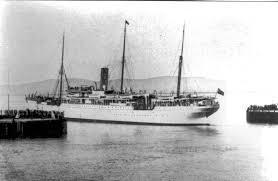FENTON, Henry Albert
| Service Number: | 20544 |
|---|---|
| Enlisted: | Not yet discovered |
| Last Rank: | Private |
| Last Unit: | Army Medical Corps (AIF) |
| Born: | North Melbourne, Victoria, 1889 |
| Home Town: | Adelaide, South Australia |
| Schooling: | Not yet discovered |
| Occupation: | Motorman |
| Memorials: | Norwood St Bartholomew's Anglican Church Honour Roll |
World War 1 Service
| 6 Aug 1918: | Involvement Private, 20544, Army Medical Corps (AIF), --- :embarkation_roll: roll_number: '23' embarkation_place: Adelaide embarkation_ship: SS Gaika embarkation_ship_number: '' public_note: '' | |
|---|---|---|
| 6 Aug 1918: | Embarked Private, 20544, Army Medical Corps (AIF), SS Gaika, Adelaide | |
| Date unknown: | Wounded 20544 |
Help us honour Henry Albert Fenton's service by contributing information, stories, and images so that they can be preserved for future generations.
Add my storyBiography contributed by St Ignatius' College
Biography of Henry Albert Fenton
By Lucy Mencel
Henry Albert Fenton was born is North Melbourne, Victoria and enlisted to join the army in Adelaide when he was 29 years old. He weighed 180Ibs and was 5 feet, 9 inches tall. Henry had a wife, Mrs. L Fenton, who was also his next of kin. Together they had one child. He and his family lived at 21 King Street, Norwood, South Australia. Henry Albert Fenton was a part of the Church of England. Fenton was training to be a motorman before he went to war. This job included driving trains and other motor vehicles. It was stated in the record of the non-military employment that Henry Albert Fenton was “keen and had a great interest in his work, he made good progress and was entirely satisfactory”. This shows that Fenton was an enthusiastic man who was very devoted to his work.
Fenton enlisted to join World War One very late in the war, on 24th of January 1918. Henry left Australia on the SS Gaika on the 6th of August 1918 and later arrived in London. Henry was working in the Australian Army Medical Corps. It was not stated where Fenton worked specifically, however, some of the units within the AAMC were working in/with hospitals, ambulances and in dentistry. Working within these medical fields meant that Fenton would have been confronted by many scary situations, where people’s lives were at risk. Seeing this may have taken a toll on Henry’s emotions, as watching people suffer and die would have been very frightening. There was a special badge that was worn by the members of the Australian Army Medical Corps. This badge included a crown, circle of leaves and the words ‘Australian Army Medical Corps’ on it. Fenton enlisted as a private, and throughout his time in World War One, he didn’t change ranks.
During Henry’s time in World War One, he caught influenza, which then went on to give him Bronchopneumonia. Having Bronchopneumonia, after influenza, was not uncommon. Bronchopneumonia is a sickness that affects the lungs and bronchi. Whilst Fenton was sick, he stayed at the Fovant Camp Military Hospital, Wiltshire. This Hospital opened in 1915 and had around 150 beds. Fenton was admitted to the Military Hospital in approximately early November 1918 and was discharged from the hospital at the start of December 1918. It took Fenton around 30 days to recover. Fenton also had tonsillitis and therefore was admitted to Australian Auxiliary Hospital on the 23rd of March 1919 and was released on the 30th of March 1919. Fenton was in the hospital for 8 days.
Troubles that the Australian Army Medical corps faced included having to treat more soldiers who had more severe injuries. This was because the opposition was now firing against the Australians with faster bullets, bigger guns and shells, chemical weapons and using trench warfare.
Fenton was lucky enough to be granted leave for four months, from 22/5/19 – 22/8/19. It was not stated what Fenton did in this time of rest, though some activities that soldiers enjoyed was to go on a holiday somewhere close by in Europe. It was important for soldiers to rest and leave the war, as it was very stressful and tiring.
Henry Albert Fenton was lucky enough to return home safely on the 18th September 1919.
Throughout the war, Australian and New Zealand soldiers showed many ANZAC qualities whilst fighting for their own countries. These qualities can include showing courage, endurance, initiative, discipline and mateship. The ANZAC spirit’s qualities were also shown in the soldier’s actions. Nowadays, Australians still call on the ANZAC spirit in times of conflict, danger, and hardship.










